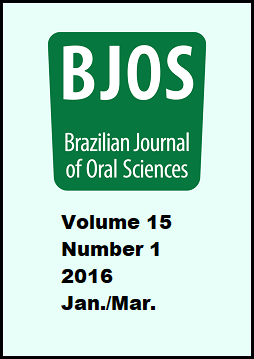Abstract
Aim: To compare the acidity of sugar-free hard candies dissolved in water and artificial saliva. Methods: Sugar-free Flopi Florestal hard candies (grape, strawberry, cherry, orange, ginger, lemon balm, fennel) were selected and grouped in 2 groups: G-1 (candies dissolved in distilled water) and G-2 (candies dissolved in artificial saliva). Candies were triturated with a porcelain pestle, yielding two samples of 20 g. Samples were dissolved in 120 mL distilled water (G-1) and 120 mL artificial saliva (20 mM NaHCO3, 3 mM NaH2PO4.H2O and 1 mM CaCl2.2H2O) (G-2), obtaining three samples of 30 mL for each of the flavors and groups. pH was measured using potentiometer and combined glass electrode. Titratable acidity was evaluated by adding 100 μL 1M NaOH aliquots until reaching pH 5.5. For statistical analysis, analysis of variance (ANOVA) was used. Means were compared by the Tukey test at 5% significance level (p<0.05) Results: All flavors of G-1 showed pH values below 5.5. Comparison of groups in the same flavor showed a significant increase in pH in flavors of G-2. Comparison of the titratable acidity between G-1 and G-2, showed that fruit flavors were significantly different from each other, with reduced acidity in G-2. Conclusions: All evaluated candies are acid, and dilution in artificial saliva raised their pH and lowered their titratable acidity, reducing their erosive potential.
References
Lussi A, Schlueter N, Rakhmatullina E, Ganss C. Dental erosion-An overview with emphasis on chemical and hispopatholigicol aspects. Caries Res. 2011;45 Suppl 1:2-12. doi: 10.1159/000325915.
Magalhães AC, Rios D, Honorio HM, Buzalaf MAR. Insights into preventive measures for dental erosion. J Appl Oral Sci. 2009 Mar-Apr;17(2):75-86.
West NX, Joiner A. Enamel mineral loss. J Dent. 2014 Jun;42 Suppl 1:S2-11. doi: 10.1016/S0300-5712(14)50002-4.
Furtado JR, Freire VC, Messias DCF, Turssi CP. [Physicolchemical aspects related to the erosive potential of acid beverages]. RFO UPF. 2010;15(3): 325-30. Portuguese.
Gambon DL, Brand HS, Veerman ECI, Dental erosion in the 21st century: What is happening to nutritional habits and lifestyle in our society? Br Dent J. 2012 Jul 27;213(2):55-7. doi: 10.1038/sj.bdj.2012.613.
Feltham EB. The power of sour candies: A dental hygienist’s battle against dietary dental erosion. CDHA J. 2010;25(1):16-8.
Correa MSNP, Corrêa FNP, Correa JPNP, Murakami C, Mendes FM. Prevalence and associated factors of dental erosion in children and adolescents of a private dental practice. 2011 Nov;21(6):451-8. doi: 10.1111/j.1365-263X.2011.01150.x.
Sovik JB, Skudutyte-Rysstad R, Tveit A B, Sandvik L, Mulic A. Sour sweets and acidic beverage consumption are risk indicators for dental erosion. 2015;49(3):243-50. doi: 10.1159/000371896.
Moynihan PJ. The role of diet and nutrition in the etiology and prevention of oral diseases. Bull World Health Organ. 2005 Sep;83(9):694-9.
Nadimi H, Wesamaa H, Janket SJ, Bollu P, Meurman JH. Are sugar- free confections really beneficial for dental health? Br Dent J. 2011 Oct 7;211(7):E15. doi: 10.1038/sj.bdj.2011.823.
Wagoner SN, Marshall TA, Quian F, Wefel JS. In vitro enamel erosion associated with commercially available original and sour candies. J Am Dent Assoc. 2009 Jul;140(7):906-13.
Davies R, Hunter L, Loyn T, Rees J. Sour sweets: a new type of erosive challenge? Br Dent J. 2008 Jan 26;204(2):E3; discussion 84-5.
Brand HS, Gambon DL, Paap A, Bulthuis MS, Veerman EC, Amerongen AV. The erosive potential of lollipops. Int Dent J. 2009 Dec;59(6):358-62.
Brand Hs, Gambon DL, Van Dop LF, Van Liere LE, Veerman EC. The erosive potential of jawbreakers. Int J Dent Hyg. 2010 Nov;8(4):308-12. doi: 10.1111/j.1601-5037.2010.00450.x.
Silva JG, Farias MMAG, Silveira EG, Araújo SM, Schmitt BHE. Evaluation of the erosive potential of acidic candies consumed by children and teenagers. J Pharm Nutr Sci. 2013;3(4):262-5.
Lazzaris M, Farias MMAG, Araújo SM, Schmitt BEH, Silveira EG. Erosive potential of commercially available candies. Braz Res Pediatr Dent Integr Clin. 2015;15(1):7-12. doi: 0.4034/PBOCI.2015.151.01.
Featherstone JDB, Lussi A. Understanding the chemistry of dental erosion. Monogr Oral Sci. 2006;20:66-76.
Lussi A, Jaeggi T. Chemical factors. Monogr Oral Sci. 2006;20:77-87.
Tenuta LMA, Fernández CE, Brandão ACS, Cury JA. Titratable acidity of beverages influences salivary pH recovery. Braz Oral Res. 2015;29. pii: S1806-83242015000100234. doi: 10.1590/1807-3107BOR-2015.vol29.0032.
Gambon DL, Brand HS, Amerongen AVN. [Acidic candies affect saliva secretion rates and oral fluid acidity]. Ned Tijdschr Tandheelkd 2007 Aug;114(8): 330-4. Dutch.
Jensdottir T, Nauntofte B, Buchwald C, Bardow A. Effects of sucking acidic candy on whole mouth saliva composition. Caries Res 2005 Nov-Dec;39(6):468-74.
Tenevuo J, Lagerloj F. [Saliva]. In: Thylstrup A, Fejerskov O. [Clinical cariology]. São Paulo: Santos; 1995. p.17-43. Portuguese.
The Brazilian Journal of Oral Sciences uses the Creative Commons license (CC), thus preserving the integrity of the articles in an open access environment.

